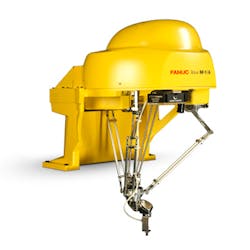With robotics industry sales in the doldrums—due to the recession and the travails of the automotive industry, in particular—robot vendors were trying a variety of techniques to stimulate interest at the International Robots, Vision & Motion Control Show June 9-11, in Rosemont, Ill., near Chicago’s O’Hare International Airport.
In lieu of its usual show floor booth, for example, ABB Robotics (www.abb.com), Auburn Hills, Mich., hauled its “Robotics on the Move—Partnership in Productivity Tour” truck trailer into the exhibit hall. The traveling, walk-through exhibit has been making the rounds of North American manufacturing plants, engineering companies, technical colleges and regional manufacturing expositions. The trailer typically draws large crowds in rural areas and smaller cities, but was making its first appearance in a major metropolitan area at the Chicago-area show, said Ted Wodoslawsky, ABB Robotics vice president, marketing, who noted that traffic levels through the unit were good.
Open spaces
KUKA Robotics Corp. (www.kukarobotics.com), likewise, was trying something different. Instead of an extensive booth display with multiple robots stepping through their paces, the company’s exhibit space was simply a wide open, carpeted area with a few chairs and a table in the middle. The only KUKA robots in sight were a few stationary units positioned on pallets around the perimeter.
“We have more than 290 different robots, so the odds of us having the specific robot here that you need are probably low anyway. So we thought we’d try just having a few chairs where we can sit down with customers and talk with them about their applications and the challenges they’re facing,” explained James C. Cooper, vice president of sales and marketing for KUKA Robotics Corp., based in Clinton Township, Mich. Cooper said he doesn’t believe that the large, open space diminished traffic at the KUKA booth space, adding, “it actually probably helped us by drawing more attention.”
ABB’s Wodoslawsky observed that sales to the automotive industry—on which the robot industry has historically been heavily dependent—are currently “almost nil.” Compared to the past, when North American auto companies ordered 10,000 to 15,000 new robots per year, he said, “if we see 2,000 to 2,500 this year, we’ll be doing well.”
Wodoslawsky confirmed, however, that food and beverage, along with solar, are two industries that are holding up well for robotics. North American sales of ABB’s high-speed Flexpicker—a parallel, or Delta-style, robot that is well-suited to food and solar markets—have already equaled the total number of Flexpickers sold in 2008, he noted.
Fanuc Robotics America Inc. (www.fanucrobotics.com), Rochester Hills, Mich., is also taking broader aim at non-automotive segments. The company introduced its first high-speed, parallel robot at the show, the M-1iA. With a six-axis model (including a three-axis wrist) weighing in at just 17 kilograms, the lightweight unit is designed for small parts handling, high-speed picking and assembly operations.
Big and strong
The Fanuc booth also offered a study in extremes. The booth featured a demonstration of a pair of the new, vision-equipped M-1iA units assembling and disassembling a 10-key keyboard. But right next to those small, lightweight units was the company’s other new entry at the show—a behemoth billed as “the world’s strongest, super heavy-duty robot.” The new M-2000iA/1200 has the highest payload—at 1,350 kilograms—and the strongest wrist of any electric six-axis robot available today, according to Fanuc. The M-2000iA/1200 is designed to meet an industry need for handling very heavy parts—such as truck, tractor and automotive frames—that previously required dual robots, conveyors, lifts or other fixed automation, the company said.
One theme relating to the vision portion of the Robots, Vision and Motion Control Show involved advances in 3D vision technology. One entire conference session was devoted to the topic, for example, with multiple scheduled presentations from Baumer; ISRA Vision; QMC and LMI; and Sick Inc., to address various flavors of advanced 3D vision technology.
And on the show floor, Motoman Inc. (www.motoman.com), a West Carrolton, Ohio-based robot vendor, rolled out eight new products, including two kinds of 3D vision solutions for use with its robots. The company’s MotoEye 3D technology relies on images taken from multiple locations along with a 3D algorithm to calculate the 3D location of a part. Its MotoSight 3D Advanced technology, meanwhile, relies on laser scan technology to facilitate its 3D capabilities. The company demonstrated a random bin picking application based on the latter approach at the show.
Liquid lens
Other advances on the vision side of the show included “liquid lens” technology from Cognex Corp. (www.cognex.com), a Natick, Mass.-based machine vision supplier. According to Michael Hahn, a representative of Cognex solution provider RR Floody Co. Inc. (www.rrfloody.com), Rockford, Ill., who was manning a Cognex booth, the technology works by applying an electrical charge to a fluid within the lens to adjust the lens focus. The lens, which was shown within a Cognex 2D matrix code reader, has no moving parts and requires just 20 milliseconds to focus with a depth of field “from contact to infinity,” Hahn said.
National Instruments Corp. (NI, www.ni.com), an Austin, Texas-based test and automation supplier, was also on the show floor with a new vision product, the Real-Time Embedded Vision System. The system is the first using Intel Core Duo processor technology to be targeted specifically at machine vision applications, said Kyle Voosen, NI business development manager, machine vision and image processing. With connectivity for both GigE Vision and Firewire cameras, the new system features a processor clock speed of 1.66 Gigahertz, and is 10 times faster than NI’s existing Compact Vision system, Voosen said. It is ideal for use in machine vision applications including high-speed sorting, assembly verification and packaging inspection, NI said.
ABB Robotics
www.abb.com
Cognex Corp.
www.cognex.com
Fanuc Robotics America Inc.
www.fanucrobotics.com
KUKA Robotics Corp.
www.kukarobotics.com
Motoman Inc.
www.motoman.com
National Instruments Corp.
www.ni.com
Robotics Industries Association
www.robotics.org
RR Floody Co. Inc.
www.rrfloody.com
Staubli Corp.
www.staubli.com
About the Author
Wes Iversen
Managing Editor

Leaders relevant to this article:
